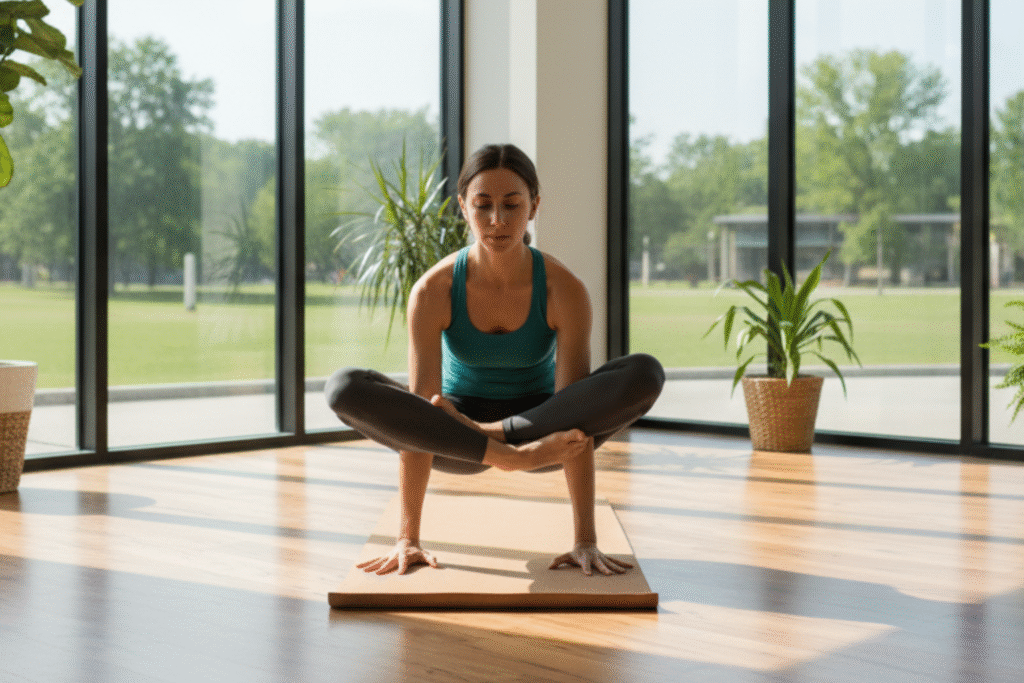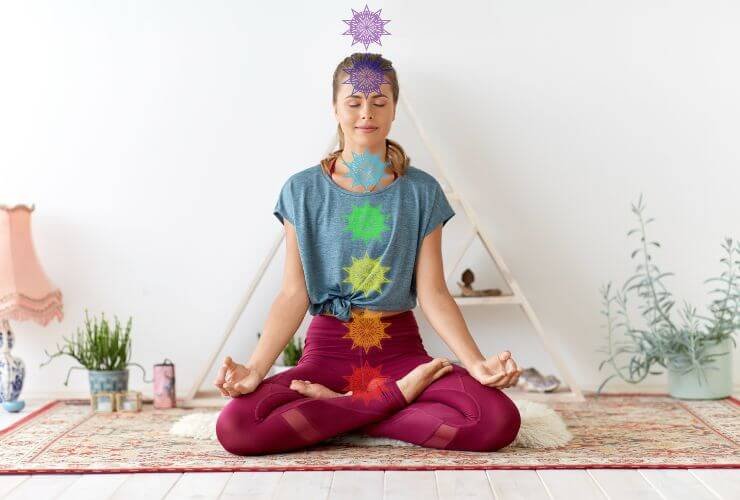Introduction
Kukkutasana (कुक्कुटासन) is a compact arm balance performed from Padmasana (Lotus): you thread your forearms through the crossed legs, plant the hands, and press the whole body up to “perch” on the palms—hence the name Cockerel/Rooster. In traditional Ashtanga Vinyasa sequencing it follows Garbha Pindasana, where the arms are already threaded; on the ninth “rock,” practitioners plant the hands and lift to Kukkutasana for a short hold. It has close relatives such as Urdhva Kukkutasana (Upward Rooster, an advanced balance with Lotus resting on the arms) and Parsva Kukkutasana (Side Rooster).
How to Do Kukkutasana (Step by Step)
- Seat & thread
Sit in Padmasana. Lean back slightly, bring knees toward the chest, then slide one arm at a time between each calf and thigh until the elbows emerge beyond the shins. Keep the feet active to protect the knees. - Hands & foundation
Place the palms flat on the floor beside the hips, fingers spread. If your arms are short or the floor feels “far away,” set blocks under the hands. - Organize the lift
On an exhale, press the floor away, broaden across the upper back (light scapular protraction), and hug the knees inward to your upper arms as you float the seat and legs. Keep your gaze slightly forward and your breath smooth. - Hold
Maintain the lift for 3–5 breaths (or as steady as is comfortable), balancing on strong, even hands. - Exit
Lower with control, untangle the arms, and release Lotus slowly (one leg at a time). Repeat with the opposite leg on top when you next attempt Padmasana.
Quick fixes: If lift-off doesn’t happen, elevate your hands on blocks and practice short “hover” attempts. Keep the head in line with the spine and avoid dumping into the wrists or shoulders.
Benefits of Kukkutasana (what practitioners commonly experience)
- Core & hip-flexor integration: the compact tuck (knees toward chest) trains abdominal bracing and hip flexion in a load-bearing shape.
- Upper-body strength & control: pressing strongly into the floor builds the triceps and shoulder-girdle stabilizers crucial for arm balances.
- Focus & proprioception: balancing while “bound” in Lotus sharpens attention and steadiness; many traditions also note invigorating effects typical of arm balances. (Treat energetic/digestive claims as traditional rather than clinical.)
Anatomy: What’s Working (and Why It Matters)
- Shoulder girdle mechanics: Effective lift comes from pushing the floor away—a combo of scapular protraction (major role for serratus anterior) with enough depression (lower traps/lats) to keep shoulders away from the ears. This positions the glenohumeral joint well and distributes load across the shoulder complex.
- Arms & wrists: Elbow extension via triceps; forearm flexors/extensors co-contract to stabilize the wrist in extension under body weight. Even pressure through knuckles and fingertips helps manage force.
- Core & hips: The lift coincides with lumbar/thoracic flexion and strong hip flexion to keep knees compact. Meanwhile, Padmasana demands hip flexion + external rotation with knees flexed; the knees aren’t built to supply the rotation—adequate hip mobility is non-negotiable for safety.
Preparatory Poses & Progressions
Lotus readiness (hips & knees)
- Baddha Konasana, Agnistambhasana/Fire-Log, Pigeon variations, and careful Padmasana prep to cultivate external rotation at the hips without torqueing the knees.
Threading & sequence context
- Garbha Pindasana (Embryo Pose) teaches the arm-thread and compact tuck; in Ashtanga, you literally roll from Garbha Pindasana into Kukkutasana to lift and balance. Practice the thread + hand plant + hover as a drill.
Pressing strength & scapular control
- Plank/Chaturanga prep and scapular push-ups to wake up serratus anterior and teach “push the floor away.”
Prop ideas
- Blocks under hands to increase clearance; short, repeated micro-holds to build tolerance in wrists/shoulders.
Curious about the harder cousins?
- Explorations of Urdhva Kukkutasana (Lotus perched on upper arms, sometimes entered from tripod headstand) and Parsva Kukkutasana (twisted) illuminate the same pressing mechanics at higher intensity. Train them only when Kukkutasana is steady.
Contraindications & When to Modify
- Wrist, elbow, or shoulder injuries / carpal tunnel: Avoid or use heavy modifications (blocks, shorter holds, or skip). Weight-bearing in wrist extension can aggravate symptoms.
- Knee or ankle issues; limited hip rotation: Kukkutasana inherits Lotus stresses—do not force Padmasana. Work hip mobility first and choose non-Lotus variants on strength days.
- Pregnancy, recent abdominal surgery or hernia; uncontrolled hypertension: Many schools advise avoiding strong compressive arm balances and Lotus binds during these conditions. Seek individualized guidance.
Red flags: sharp knee pain in Lotus, wrist/hand numbness, or shoulder pinching—come out immediately and regress.
Coaching Cues (to make it work)
- Push + dome: press the floor to protract the scapulae; feel the upper back broaden (no shoulder collapse).
- Compact the shape: keep knees hugging in and pelvis slightly tucked as you exhale and lift.
- Even hands: distribute weight through the whole hand—especially the bases of the index finger and thumb—to spare the wrists.
- Props are smart: if clearance is the limiter, blocks turn “no lift” into “small hover,” which trains the pattern safely.
Variations of Kukkutasana (for different bodies)
- Supported Kukkutasana drills: hands on blocks; thread just one arm at a time, then both; practice 1–2-second hovers.
- Advanced family: Urdhva Kukkutasana (A/B entries; often from tripod headstand or from knees/seated) and Parsva Kukkutasana (twisted). Attempt only with expert guidance.
Bottom line: Build Lotus mobility patiently, train serratus-driven pressing, and use blocks until the lift feels light. In Kukkutasana, a small, clean hover with happy joints beats a forced, shaky perch every time.





